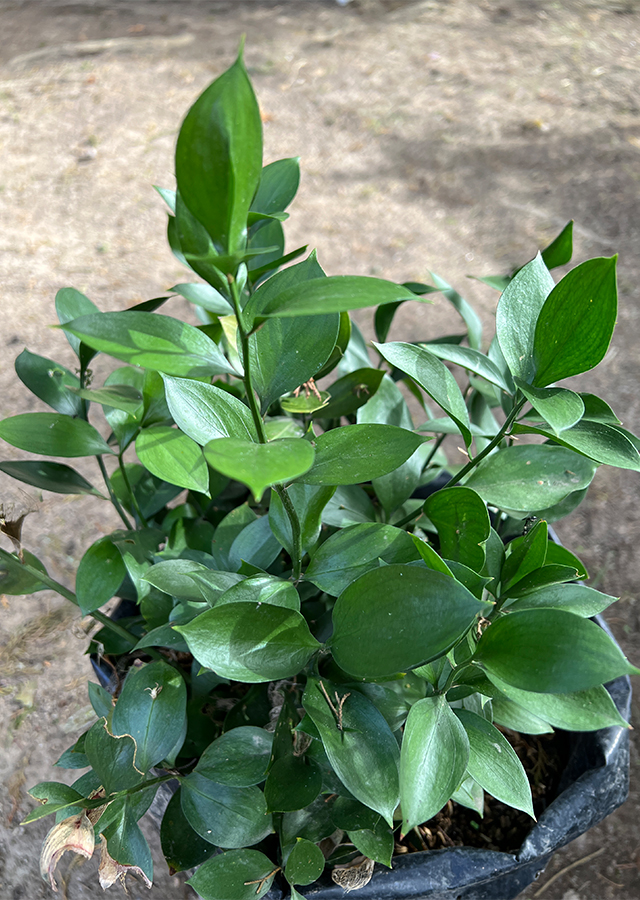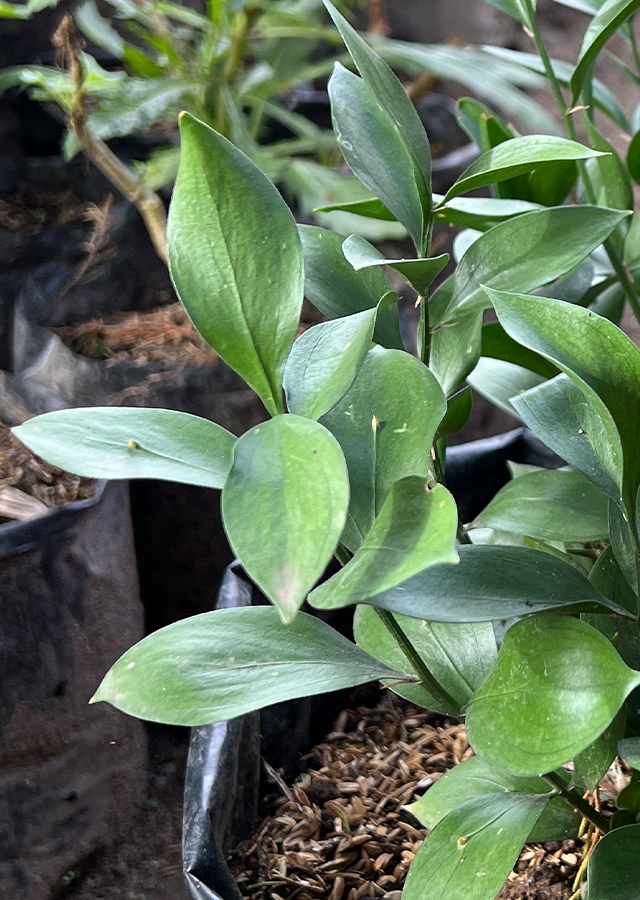Traditional Herbs from Ruscus hypophyllum
treating_kidney_stones
- Prepare ruscus rhizomes, wash until clean.
- Boil until boiling.
- Let it warm/cold.
- Strain then drink to treat kidneys.
treat_itching
- Prepare Wash the ruskus rhizome until clean.
- Crush it until it becomes a paste.
- Squeeze out the water.
- Apply to treat itchy skin.
What is Ruscus hypophyllum Looks like??



Parts of Ruscus hypophyllum that could be used
- Rhizome
Ruscus hypophyllum Distribution
This plant comes from the Mediterranean area, spread across Africa and small islands in England. Apart from the fact that the leaves can last a long time, they are often used as filler in flower arrangements or decorations, this plant is a medicinal plant for several diseases. The use of ruskus as medicine has a long history in Palestine, ruskus rhizome extract is used to treat skin diseases. While in Central Italy it is used to treat warts and calluses, in T�rkiye a decoction of ruskus rhizomes is drunk to treat eczema, kidney stones and nephritis. In some areas in Italy it is also used to treat diarrhea.Agroecology of Ruscus hypophyllum
Ruscus hypophyllum prefers clay soil, rich in nitrogen and with a C/N ratio higher than 10. The soil it prefers is soil with an acidic pH (3.3-7.3). At Kroumirie, the presence of Ruscus hypophyllum is rare above 650 m, between 50 and 650 m, with a maximum at around 450 m. This species has an affinity for low slopes (0-10%). The planting medium used is a mixture of soil and humus in a ratio of 2:1. This plant is also resistant to seasonal changes, withstanding both the rainy season and the dry season. Resistant to drought.
Morphology of Ruscus hypophyllum
- The rhizome is creeping, thick, sympodally branching to form an oval pyramidal bush. Stems appear striated, green, erect, and much branched, growing up to 1 m tall.
- Leaves are reduced to triangular scales up to 5 mm long and replaced incidentally by cladodes stiff (flattened leaf-like stem tissue also known as asphylloclades) 2\u201318 cm long and 1\u20138 cm wide, each arising from leaf axils,\u00a0cladodes are ovate, whole, dark green, and pointed.
- Flowers\u00a0small, emerge from the axils of small bracts in the center of the upper surface of the cladode, each with a short greenish-white pedicle, approx. approximately 3 mm, and consists of two whorls of three segments containing papillae. In the latter, male and female plants are very similar in appearance; fused around a superior unilocular ovary, which has a subsessile capitate stigma, while the male flowers have three stamens and a green or purple filament fused into a tube around the undeveloped ovary.
- Fruit\u00a0is a round, bright red fruit with a diameter of 8 -14 mm with 1-4 large seeds.
Cultivation of Ruscus hypophyllum
Conventionally, R. hypophyllum is propagated using seeds, cuttings and rhizome separation. Ruscus can also be propagated using tissue culture techniques.
Ruscus hypophyllum, more details :
Chemical Content of Ruscus hypophyllumSteroidal glycosides namely (23S,25R)-23-hydroxyspirost-5-en-3 beta-yl O-alpha-L-rhamnopyranosyl-(1 -> 4)-beta-D-glucopyranoside (1), 1 beta-hydroxyspirost- 5,25(27)-dien-3-beta-yl O-alpha-L-rhamnopyranosyl-(1 -> 4)-beta-D-glucopyranoside (2), (22S)-16 beta,22-dihydroxycholest-5en-3 beta-yl O-alpha-L-rhamnopyranosyl-(1 -> 4)-beta-D-glucopyranoside ( 3), (22S)-16 beta-[(beta-D-glucopyranosyl)oxy]-22-hydroxycholest-5-en-3 beta-yl O-alpha-L-rhamnopyranosyl-(1 -> 4)-beta-D-glucopyranoside (4), (22S)-16 beta-[(beta-D-glucopyranosyl)oxy]-22-hydroxycholest-5 -en-3 beta-yl beta-D-glucopyranoside (5), (22S)-16 beta-[(beta-D-glucopyranosyl)oxy]-3 beta,22-dihydroxycholest-5-en-1 beta-yl O-alpha-L-rhamnopyranosyl-(1 -> 2)-(3,4-di- O-acetyl-beta-D-xylopyranoside) (6), and (22S)-16 beta-[(beta-D-glucopyranosyl)oxy]-3 beta,22-dihydroxycholest-5-en-1 beta-yl O-alpha-L-rhamnopyranosyl(1 -> 2)-O-[beta-D-xylopyranosyl-(1 -> 3)]-beta-D-xylopyranoside (7). spirostanol saponins (1-5) include new saponins (4) and nine furostanol saponins (6-14) include three new saponins (9-11), along with a known cholestanol glycoside (15) and a new cholestanol glycoside (16).
Benefits of Ruscus hypophyllum
Treats skin diseases, warts and calluses, treats eczema, kidney stones, nephritis and diarrhea.
Simplisia of Ruscus hypophyllum
Another Facts for Ruscus hypophyllum :
Synonym of Ruscus hypophyllumPlatyruscus hypophyllum (L.) A.P.Khokhr. & V.N.Tikhom., Ruscus lugubris Salisb., Ruscus trifoliatus Mill.
Habitus of Ruscus hypophyllum
Bush. Annual shrub, height reaches 0.42 m
Habitat of Ruscus hypophyllum
- Mainland
No comments:
Post a Comment